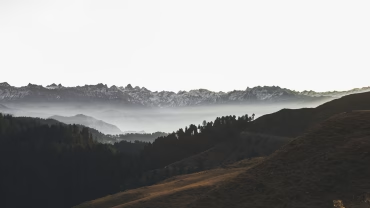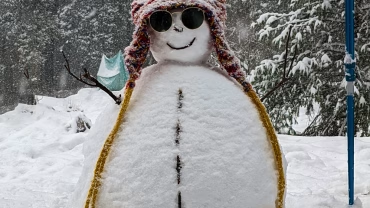Wildlife and Nature October 9, 2025
Exploring the Majestic Snow Leopard in Spiti Valley: A Comprehensive Guide
Introduction to the Snow Leopard
The snow leopard, an enigmatic and strikingly beautiful feline, is found predominantly in the mountain ranges of Central and South Asia. This elusive predator holds significant ecological importance, as it plays a critical role in maintaining the balance of its alpine habitat. Known scientifically as Panthera uncia, the snow leopard is specially adapted to survive in harsh, cold environments, often inhabiting rugged terrains at elevations ranging from 3,000 to 5,500 meters above sea level. Its thick fur, long tail, and powerful limbs make it an exceptional climber, allowing it to navigate steep cliffs with ease.In Spiti Valley, a region located in the northern Indian state of Himachal Pradesh, snow leopards showcase their prowess within an expansive and barren landscape characterized by high-altitude plateaus and deep gorges. This region serves as a critical habitat for the snow leopard due to its abundance of prey species, such as the blue sheep and ibex, as well as various other herbivores. The presence of snow leopards in Spiti Valley is a testament to the health of the ecosystem and the intricate interdependence of species within this unique habitat.As a species, snow leopards are classified as vulnerable by the International Union for Conservation of Nature (IUCN). Their conservation is a priority not only due to their decreasing populations, attributed mainly to habitat loss, poaching, and climate change, but also because of their role as an apex predator. Protecting snow leopards ensures the stability of their ecosystem, helping to regulate herbivore populations and maintain vegetation diversity. Furthermore, initiatives to conserve these magnificent creatures can significantly benefit local communities by promoting eco-tourism and sustainable livelihood opportunities. The plight of the snow leopard serves as a poignant reminder of the urgent need for wildlife conservation in vulnerable regions like Spiti Valley.Understanding Spiti Valley: The Perfect Habitat
Spiti Valley, nestled in the northern Indian Himalayas, presents a unique geographical landscape that serves as an ideal habitat for the elusive snow leopard. This remote region is characterized by its high altitude, with elevations ranging from 3,500 meters to over 6,300 meters above sea level. Such heights create a distinct environment that supports diverse flora and fauna, fundamentally shaping the ecosystem necessary for the survival of the snow leopard.The climate of Spiti Valley is profoundly influenced by its elevation. With an arid cold desert climate, it experiences extreme temperature variations, where summer temperatures can fall between 15°C to 20°C, while winters can plunge to a frigid -30°C. This remarkable shift contributes to the geological diversity of the valley, encompassing rugged mountain terrains, steep cliffs, and rolling grasslands. These diverse habitats provide ample cover and hunting grounds for the snow leopard, which prefers rocky, steep areas for its natural agility and prowess as a predator.Furthermore, the valley’s unique geological features, such as deep gorges, wide riverbeds, and varied altitudes, create a rich tapestry of ecosystems that support a wide range of prey species. These include blue sheep, ibex, and various rodents, all essential for the snow leopard’s diet. The presence of these prey animals is vital, as they directly influence the hunting patterns and survival strategies of the snow leopard.In conclusion, the combination of altitude, temperature ranges, and the valley’s intricate landscape make Spiti Valley an exceptional habitat for the snow leopard. Its unique geographical characteristics not only foster the survival of this majestic creature but also maintain the delicate balance of the region’s biodiversity.Best Times to Spot Snow Leopards
Spotting snow leopards in Spiti Valley requires careful planning, particularly regarding the seasons and times of day. The optimal months to witness these elusive creatures are typically from late November to early March. This timeframe corresponds with the snow leopard’s breeding season, during which they exhibit increased activity in search of mates. Additionally, the winter months bring about a stark contrast between the bright white snow and the greyish fur of the leopards, enhancing visibility during daylight hours.During the day, particularly in the early morning and late afternoon, snow leopards are more active and more likely to be spotted as they hunt and patrol their territories. The late afternoon is often recommended for sightings since these big cats are known to have a preference for hunting during this period. Moreover, the lower sun angle provides better natural lighting for photography and observation. As temperatures can drop significantly during nighttime, leopards often seek shelter, making the daytime hours more advantageous for wildlife enthusiasts.Weather patterns also play a crucial role in snow leopard visibility. Clear skies with minimal cloud cover typically enhance sighting opportunities. Heavy snowfall or poor visibility can hinder tracking these magnificent creatures. It is crucial for wildlife watchers to be aware of the migratory patterns of the prey species, such as blue sheep, which usually move to lower altitudes during harsh winter conditions. This shift increases the chances of encountering snow leopards hunting for food.For those planning a trip to Spiti Valley, aligning the journey with the peak winter months when temperatures are cold but the skies are clear will provide the best possibilities for spotting snow leopards in their natural habitat.Essential Equipment for Snow Leopard Tracking
Tracking the elusive snow leopard in the Spiti Valley necessitates proper preparation and equipment to ensure a safe and successful experience. The harsh conditions prevalent in this region demand essential gear that not only aids in spotting these magnificent creatures but also ensures the comfort and safety of the tracker. The first key consideration is the use of high-quality optics. Binoculars with a magnification of at least 10×42 are highly recommended, providing a clear and closer view of distant wildlife without alarming the snow leopards. Furthermore, a camera equipped with a zoom lens, ideally ranging between 200mm to 600mm, will allow for high-resolution images from afar, capturing the beauty of these animals in their natural habitat.Equally important is suitable clothing designed for extreme weather conditions. Layering is the best strategy for warmth and versatility. Start with a moisture-wicking base layer, followed by an insulating mid-layer such as fleece or down, and conclude with a waterproof and windproof outer layer. Thermal gloves, hats, and neck gaiters are critical components that need to be included in your gear list to protect from severe cold. Opt for waterproof hiking boots with good traction to navigate the rocky terrain safely while maintaining warmth.Additional gear can significantly enhance the tracking experience. A sturdy backpack is essential for carrying all equipment comfortably. Packable seat pads can be useful for long periods of observation, allowing trackers to remain stationary while waiting for the snow leopard to appear. Moreover, having a portable GPS device can assist in navigating the mountainous landscape while tracking routes and markings left by these cats. With the right equipment in hand, the quest to witness the majestic snow leopard in Spiti Valley becomes an unforgettable endeavor.Logistical Considerations for Your Trip
Planning a trip to Spiti Valley for snow leopard watching requires careful attention to various logistical aspects. The remoteness of the region necessitates a well-thought-out approach to transportation, accommodation, and necessary permits.Firstly, reaching Spiti Valley requires a reliable means of transportation. The nearest major town is Manali, from where travelers can rent a car or take a shared taxi. The journey through breathtaking mountain roads typically takes around 10 to 12 hours, depending on weather conditions. Alternatively, one can access Spiti from Shimla. Bus services operate between these towns and Spiti, although schedules may vary. For those seeking a more adventurous approach, motorcycles are also a popular option for navigating the challenging terrain. Regardless of the mode of transport chosen, it is essential to be prepared for high-altitude conditions and potential road closures due to snowfall.Once you arrive, accommodation options vary significantly across Spiti Valley. Travelers can find everything from basic guesthouses to more comfortable homestays. It is advisable to book accommodations in advance during the peak season, usually from May to October, as availability can become limited. The local homestays not only provide comfortable lodging but also an opportunity to connect with the local culture and cuisine.Lastly, it is crucial to obtain the necessary permits for visiting certain areas within Spiti Valley. Foreign tourists typically need an Inner Line Permit (ILP) to access the restricted regions, particularly around Kibber and the snow leopard habitats. Permits can be obtained via the local administration office in Kaza or through authorized travel agencies. It is recommended to have these logistics sorted out well in advance to ensure a smooth travel experience while exploring the majestic snow leopard in its natural habitat.Conservation Efforts in Spiti Valley
The Snow Leopard, an elusive and magnificent predator, plays a crucial role in the ecosystem of Spiti Valley. Ongoing conservation efforts are vital to ensuring the survival of this species in a region threatened by habitat loss, poaching, and climate change. Various local initiatives and partnerships have emerged in response to the challenges facing snow leopards and their habitat.One notable organization involved in conservation is the Snow Leopard Trust, which collaborates with local communities to protect wildlife while simultaneously promoting sustainable livelihoods. Their approach emphasizes education and awareness, helping locals understand the ecological importance of snow leopards and the benefits of coexisting with them. This has fostered greater community engagement and support for conservation initiatives.Additionally, the Himachal Pradesh Forest Department plays a significant role in formulating strategies to mitigate human-wildlife conflict. By establishing wildlife corridors and promoting eco-friendly practices, they aim to reduce the encroachment of human activity into snow leopard habitats. This collaborative approach involves local herders, who are educated on non-lethal methods for protecting their livestock from potential snow leopard predation.Tourism also provides a significant opportunity for conservation funding in the Spiti Valley. Responsible wildlife tourism creates awareness and generates revenue that can be reinvested into conservation programs. Nevertheless, it is essential that tourism activities remain eco-friendly and do not disturb wildlife habitats. Community-based tourism initiatives, which involve local families in guiding and hospitality, ensure that the benefits of tourism are shared and contribute to conservation efforts.In conclusion, conservation initiatives in the Spiti Valley effectively combine local knowledge, community involvement, and responsible tourism. By fostering partnerships between various organizations and local populations, these efforts provide a sustainable pathway towards ensuring the protection of the snow leopard and its critical habitat in this unique ecological zone.Cultural Significance of Snow Leopards in Local Communities
In the remote and austere landscapes of Spiti Valley, the presence of the snow leopard extends far beyond its ecological importance; it permeates the cultural narratives and traditions of the local communities. Revered as a symbol of strength and mystery, the snow leopard holds a prominent place in the folklore of the region. Various myths and legends are entwined with the majestic feline, exemplifying not only its physical grace but also its role as a guardian of the mountains.For the inhabitants of Spiti Valley, the snow leopard is often perceived as a spiritual figure. Local tales depict the snow leopard as a protector, illuminating its connection to local beliefs regarding nature and conservation. Stories are shared across generations that feature the snow leopard as a pivotal character, embodying wisdom, courage, and the harsh realities of survival in the high-altitude terrain. This symbiotic relationship between the people and the snow leopard fosters a deep respect for the animal, which consequently encourages community-driven conservation efforts.The association of snow leopards with traditional livelihood practices further accentuates their cultural significance. For pastoralist communities, the presence of these big cats serves as a constant reminder of the delicate balance between nature and human existence. While they pose challenges to livestock management, the communities have developed strategies to coexist with these apex predators. By integrating local perspectives and addressing cultural sensitivities, conservation initiatives are deemed more effective and culturally appropriate, indicating that the significance of snow leopards extends beyond mere wildlife conservation.This intricate bond between the snow leopard and local communities in Spiti Valley exemplifies how cultural narratives influence conservation strategies, highlighting the necessity of incorporating traditional knowledge and beliefs into contemporary conservation efforts.Ethics of Wildlife Observation
The observation of snow leopards in their natural habitat offers a unique opportunity for wildlife enthusiasts and photographers alike. However, it is crucial to engage in ethical practices to ensure the safety and well-being of these magnificent creatures. Understanding and respecting the ethical considerations associated with wildlife observation not only benefits the snow leopards but also contributes to the preservation of their environment.When planning a wildlife photography expedition, consider minimizing your presence in the snow leopard’s territory. This includes adhering to guidelines set by local conservation authorities and opting for a respectful distance rather than an intrusive approach. Keep in mind that snow leopards are inherently shy animals, and close interactions can induce stress and alter their natural behaviors. Using long lenses allows photographers to capture high-quality images without disturbing the animals, thus maintaining a respectful boundary.Additionally, it is essential to minimize human impact on the delicate ecosystems of Spiti Valley. When moving through the area, all visitors should avoid leaving trash, which can harm the wildlife and disrupt their habitat. Campers and trekkers should also take care to avoid disturbing flora and fauna, adhering to established trails whenever possible. It is advisable to educate oneself about the local wildlife and ecosystem to enhance the experience while fostering respect and awareness of environmental responsibilities.Finally, engaging with local guides can greatly enhance the ethical experience of wild observing. These guides typically possess invaluable knowledge about the snow leopards and their habitats while emphasizing the importance of conservation. By fostering a mutual respect between tourists and wildlife, we can ensure that both species continue to thrive in the breathtaking landscapes of Spiti Valley.How to Plan Your Snow Leopard Adventure
Embarking on a snow leopard adventure in Spiti Valley requires careful planning to ensure a fulfilling and safe experience. The first step in your journey is to consider when to visit the region. The best time for snow leopard sightings is during the winter months, from late November to early March, when the animals are more active and can be spotted more easily in the snow-covered landscapes.Once you have identified your travel window, it is crucial to book your tours in advance. Several travel agencies specialize in wildlife tourism and offer guided expeditions focusing on snow leopard viewing. Look for operators that emphasize responsible travel practices and have a strong conservation component, as this ensures your adventure contributes positively to the local ecosystem. Joining a conservation-focused travel group not only supports critical initiatives aimed at protecting these magnificent creatures but also enhances your experience through knowledgeable guides and fellow enthusiasts.Before your journey, adequate preparation is essential. Physically, ensure that you engage in activities that enhance your endurance and stamina, as trekking in Spiti’s rugged terrain demands a good level of fitness. Mental preparation is equally important; familiarizing yourself with the habits and behaviors of snow leopards can enrich your understanding and appreciation during sightings. Consider reading relevant literature or watching documentaries about these elusive animals and their habitats.Furthermore, pack appropriately for the cold climate. Layering your clothing, with moisture-wicking base layers and insulated outer layers, will keep you warm and comfortable. Don’t forget essential equipment such as binoculars and a good quality camera, which can enhance your viewing experience while documenting your incredible adventure. By following these steps, you can set yourself up for a remarkable encounter with the snow leopards of Spiti Valley.




Comment (0)